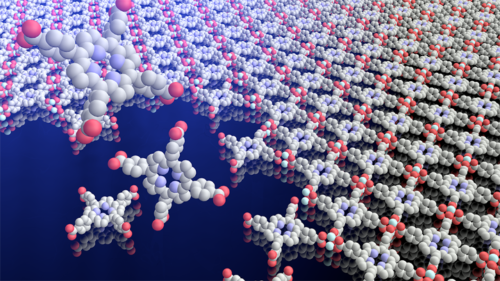(Invention of teeny-tiny organic films could enable new electronics)
2019/11/7 アメリカ合衆国・シカゴ大学

・ シカゴ大学、コーネル大学およびアルゴンヌ国立研究所(ANL)が、有機材料による極薄膜を効率的に生成する技術を開発。新機能を備えた次世代エレクトロニクス実現への足掛かりとなる可能性が期待できる。
・ 無機材料で原子数個分の極薄膜を作製する技術は、携帯電話の小型化や太陽電池の普及を促進してきたが、これと同様の製造プロセスを有機材料(炭素を含むもの)には適用しにくい。
・ 材料の原子薄膜を積層することで新しい機能が発現し、有機薄膜では高い利便性が得られるが、その薄さの制御と大量製造が課題となっている。
・ 新技術では、油分と水分を混合した際に起こる分離に着想。分離の境目に形成される隙間をモールドとして活用し、理想的な薄膜を作製する。
・ リアクタの半分を液体 A で満たしてから液体 B を追加し、両液体の境目に微細チューブで材料を注入し、継ぎ目の無い薄膜を生成。その後液体を蒸発または廃水して薄膜が完成する。無機薄膜生成では高温度が必要だが、同技術は室温下で行えるため、極めて効率的。
・ また、リアクタ底部に予め無機材料基板を配置することで、有機・無機の各薄膜を組合せる革新的な手法も開発。両薄膜は相互補完の関係にあるが、それぞれの生成条件が顕著に異なるため、取り合わせが困難であった。
・ 同技術による有機薄膜をキャパシタとして試験した結果、エレクトロニクスでの利用で期待できる性能を確認。さらに、ナノボット、水や光に反応して変形するファブリック、水ろ過膜に加え、量子コンピューターの q ビットまで、広範囲にわたるアプリケーションが可能と考える。
・ 本研究には、米空軍科学局(AFOSR)、米国立科学財団(NSF)、Camille and Henry Dreyfus
Foundation および米エネルギー省(DOE)が資金を提供した。
URL: https://news.uchicago.edu/story/invention-teeny-tiny-organic-films-could-enable-newelectronics
(関連情報)
Science 掲載論文(アブストラクトのみ:全文は有料)
Wafer-scale synthesis of monolayer two-dimensional porphyrin polymers for hybrid superlattices
URL: https://science.sciencemag.org/content/early/2019/11/06/science.aax9385
<NEDO海外技術情報より>
Abstract
The large-scale synthesis of high-quality thin films with extensive tunability derived from molecular building blocks will advance the development of artificial solids with designed functionalities. We report the synthesis of two-dimensional (2D) porphyrin polymer films with wafer-scale homogeneity in the ultimate limit of monolayer thickness by growing films at a sharp pentane/water interface, which allows the fabrication of their hybrid superlattices. Laminar assembly polymerization of porphyrin monomers could form monolayers of metal-organic frameworks with Cu2+ linkers or covalent organic frameworks with terephthalaldehyde linkers. Both the lattice structures and optical properties of these 2D films were directly controlled by the molecular monomers and polymerization chemistries. The 2D polymers were used to fabricate arrays of hybrid superlattices with molybdenum disulfide that could be used in electrical capacitors.


